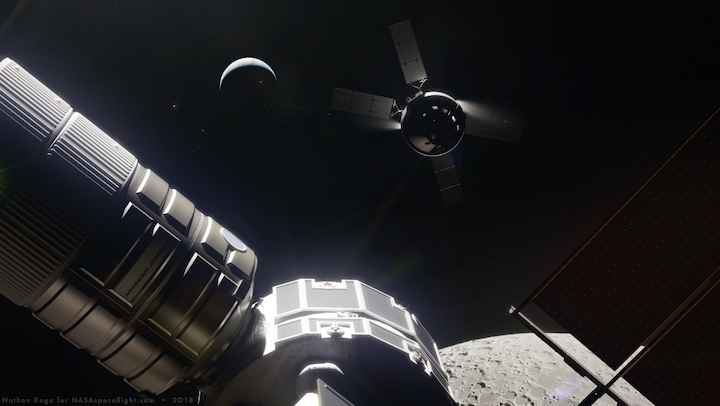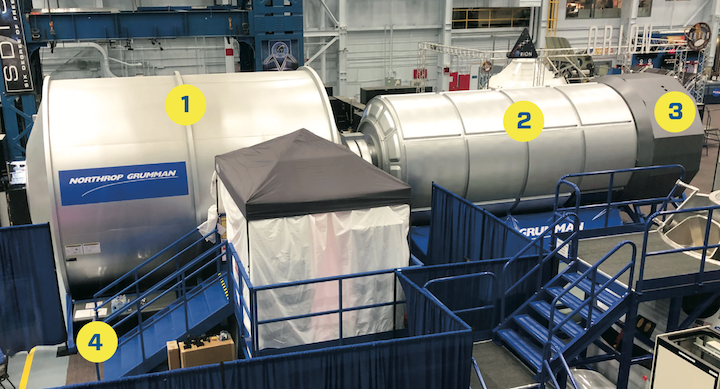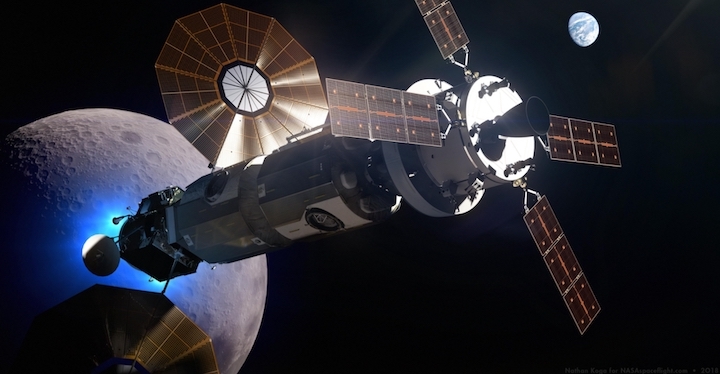12.05.2019

Northrop Grumman Innovation Systems (NGIS) and NASA have completed a series of tests on a full-scale mockup of NGIS’s proposed Deep Space Gateway habitat modules. The test, conducted at NASA’s Johnson Space Center in Houston, Texas, comes as part of Northrop Grumman’s participation in the Next Space Technologies for Exploration Partnerships-2 (NextSTEP-2) program.
While the testing was conducted on mockups, the proposed modules at the Johnson Space Center were “outfitted with everything needed by an Orion astronaut crew to simulate Cislunar Gateway missions,” noted NGIS in a press release.
To this end, the mockups were fitted with crew exercise equipment, life support systems, a toilet, a viewing window, a galley, sleeping quarters, science racks, a radiation shelter, robotics workstations, and an airlock/tunnel.
These elements were located within three modules, including a 7 m x 4.4 m Habitat, a 6 m x 3 m Habitat, and the 2.5 m x 1 m Airlock.
The larger Hab module was fitted with two axial and two radial docking ports – with one of each accessible for the hands-on testing. The accessible axial port is where an Orion would dock and through which astros would enter the Gateway.

This week’s test occurred as part of phase two of the NextSTEP-2 program and followed more than 18 months of physical development after the on-paper phase one part of the program.
Overall, the design of NGIS’s cislunar habitat system is based on the company’s currently-operational Cygnus resupply vehicle for the International Space Station.
“From Northrop’s perspective, we have a solid foundation and history with our Cygnus vehicle supporting the ISS and human spaceflight world. So it was easy to draw a lineage from that and carry it forward,” said Chad Davis, Functional Manager in the Integrated Operations Directorate for NGIS, in an interview with NASASpaceflight’s Chris Gebhardt.
“We actually just completed our debrief from [the test], which is very positive. We had a complement of four [astronauts] that were in the hab Monday through Thursday. They were two former Shuttle/ISS type astronauts and then we had two astronaut candidates that supported the test evaluation.
“And they essentially went through a list of different tasks that both NASA had developed, and we, Northrop, also provided a list of tasks that we wanted the crew to do that sorta accentuated or showed off some of the features that we consider outliers for our concept.”
The tests were designed to take the crew through all of the operations they would have to do if they were actually living on the Gateway.
“Essentially, [we] had the four crewmembers that were playing the role of being the crew that arrived at the gateway in orbit around the moon, and they went through two days, two active days, worth of tasks they would be doing as a mission, a gateway mission,” related Mr. Davis.
This included performing mock observations of the moon, conducting telerobotics operations for a rover on the lunar surface, and daily maintenance tasks like cleaning the toilet, replacing filters, and other general upkeep necessary for permanent space vehicles.
Importantly, the tests also provided feedback on how the astronauts interpreted the various instructions written up by NASA and NGIS as well as how the proposed sizes of the hab modules worked from a functionality standpoint.
“With our heritage towards the Cygnus vehicle, our gateway itself is comprised of two different-sized module elements. One of those is the size of the Cygnus, diametrically, and the other is similar to an ISS diameter module.
“And so that gave the crew the ability to evaluate the different sizes and how our team have worked over the past year and a half to optimize the internal layout to make it the most efficient for the crew,” said Mr. Davis.
With the test complete, Mr. Davis noted that NGIS received positive feedback from NASA and the astronauts regarding the mockups and their layout – validating for NGIS that they provided the best possible product they could for this evaluation.
But NGIS is not the only company participating in Phase 2 of the NextSTEP-2 program. Four other aerospace corporations are also involved – with NASA conducting the same kind of hands-on mockup testing with them as well.

Crucially, part of Phase 2 of NextSTEP-2 is not just mockup trainings but each company walking NASA through their approach to how they would build the physical flight articles of their products.
For NGIS, this included evaluating what elements from Cygnus would need to change, what Cygnus systems or subsystems could be carried over to the Gateway hab, and what elements would need to be tweaked from Cygnus to support a permanent cislunar habitat.
“All of those things are broken down into the different subsystem groups that are part of the evaluation; we’re calling them DAC (Design Analysis Cycle). And our final DAC review is next, at the end of next month here, [and we’ll] present those areas that we’ve identified as what our plans are to meet the proposed requirements for our flight configuration,” said Mr. Davis.
More than just the flight experience with Cygnus, NGIS is also pulling from its vast array of experience with GEO (Geostationary) satellites.
Unlike Cygnus, these spacecraft are exposed to higher levels of radiation and require different kinds of radiation hardening that Cygnus does not as a Low Earth Orbit craft but that the Gateway hab will require due to its operational placement beyond the vast majority of Earth’s protective magnetic field.
“We’re leveraging all of the capabilities within the company itself to help us understand what our new proposed configuration would actually look like, or what we would propose it to look like to meet NASA’s needs,” said Mr. Davis.
Exactly when NASA will make a decision on which company to award a contract to for construction of the habitat elements of the Deep Space Gateway is unknown right now – nor is the impact of the 2024 human lunar landing initiative on the Gateway or if the Gateway would even be needed to accomplish the directive.
Regardless, a habitat construction decision will likely be made within the coming year if the Gateway’s development, construction, launch, and assembly are to remain on track per the project’s currently proposed timeline.
Quelle: NS
